Bioimpacts. 2025;15:30401.
doi: 10.34172/bi.30401
Scientific Analysis
Bibliometric study of BioImpacts using a technological impact approach
Leila Mirzapour Conceptualization, Data curation, Formal analysis, Methodology, Visualization, Writing – original draft, Writing – review & editing, 
Fatemeh Sheikhshoaei Investigation, Supervision, Writing – review & editing, , * 
Author information:
Department of Medical Library and Information Sciences, School of Allied Medical Sciences, Tehran University of Medical Sciences, Tehran, Iran
Abstract
Introduction:
The number of citations received by articles is a key indicator of a journal's quality and effectiveness within its field. This, in turn, influences the ability to secure funding for ongoing publication, establishing a suitable policy for its promotion, and helping researchers selecting an appropriate journal to publish their findings or find information they require. Meanwhile, one way to measure a journal's technological impact is to examine the patent citations attached to its articles. This study aims to evaluate the technological impact of BioImpacts (BI) by examining the patents’ citations to its articles.
Methods:
This descriptive study was conducted using the bibliometric method with a technological impact approach. The published BI belonged to the years 2011-2023. Data were extracted using the Lens and Espacenet databases. Descriptive statistics and Excel software were applied for data analysis.
Results:
The results revealed that BI had a 10% technological impact. Original research contributed to most of the cited articles (27). American patents were the most impacted by BI’s articles. Moreover, human necessities (A) and chemistry and metallurgy (C) were two main technological sections influenced by BI’s articles. The most active and influential country was Iran and the most active and influential organization was Tabriz University of Medical Sciences.
Conclusion:
Based on the present research findings, the technological impact of BI is considerable; so, it is important to present information about this issue on the journal’s website and adopt appropriate policies for further development of BI in this field.
Keywords: BioImpacts, Bibliometric study, Technology impact, Patent citation
Copyright and License Information
© 2025 The Author(s).
This work is published by BioImpacts as an open access article distributed under the terms of the Creative Commons Attribution Non-Commercial License (
http://creativecommons.org/licenses/by-nc/4.0/). Non-commercial uses of the work are permitted, provided the original work is properly cited.
Funding Statement
No specific grant was granted for this research by the public, private, or nonprofit funding organizations.
Introduction
With the growing number of scientific journals, stakeholders such as publishers, readers, policymakers and evaluators have been increasingly interested in the journal’s quality ratings and rankings. An essential tool for securing funding to keep publishing a journal is to know its quality and ranking. These two items are employed by researchers to select an appropriate journal to publish their findings or find information they require. Furthermore, promotion points are granted based on the impact and performance of academic researchers and the rankings of universities are developed using this information.1-4
Citation is one of the main criteria for evaluating the quality of a journal and its articles.5 Citation indices, which present the journal's impact on science and technology, and the contributions made by individuals, organizations, and nations, are derived from the citations of scientific and technical works.4,6-8
Narin et al was the first one who used patent citations on non-patent literature (NPL) as an indicator of the impact of science on technology.9 Since then, many researchers have investigated the impact of science on technology in various fields, including nanotechnology,10 energy,11 biomedicine,12 social sciences and humanities,13 parasitology14 etc. In these studies, patents and scientific articles were technology and science indicators, respectively.
The patent's references form prior art, which aids in determining if the application satisfies the novelty criteria for patentability.15 Patents and NPL like books, scientific papers, technical documents, and congress articles, are all cited.16 Scientific journal articles make up around 48-90% of NPL,9,6-20 and the rate of patent citations to scientific articles in different fields is about 4–15%.12,14,21
Bibliometric method is utilized to investigate the influence of science on technology. Numerous factors have so far been examined, including the number of citations to scientific articles, features of scientific documents, individuals, citing nations, impacted technological areas, and journal’s impact factor.22
BioImpacts (BI), published by Tabriz University of Medical Sciences (TUOMS) in English since 2011. This journal focuses on articles in the fields of pharmaceutical and biomedical sciences.23 As one of the top journals approved by Iran’s Ministry of Health and Medical Education, BI is indexed in the Web of Science (WoS), Scopus, and Medline. According to Zahedi et al, BI is cited by the United States Patent and Trademark Office (USPTO) patents and received three citations until 2018.24 Given that Zahedi's analysis was published several years ago and that BI is still published, more up-to-date and comprehensive data are required to assess its impact on technological development. To our knowledge, no further research has been done in this area. Thus, the present research aims to perform a bibliometric study of BI using a technological impact approach by examining the patent citations to its articles.
Materials and Methods
The bibliometric method was applied to conduct this descriptive analysis using a technological impact approach based on patent citations to the articles published in BI. The Lens database was used to identify articles cited in the patents. This database offers search and analysis capabilities for more than 268 million scientific documents and 153 million patents. Moreover, it provides information on both past and future references to scientific documents and patents. The Medline/PubMed database, which indexes BI, acts as one of the data sources for Lens scientific literature.25
Using the scientific documents app of the Lens database, BI’s articles from the first year of publication (2011) until the end of 2023 were extracted by searching for the journal's title. The retrieved documents were narrowed down to those cited by the patents. The procedure for selecting the retrieved articles is depicted in Fig. 1.
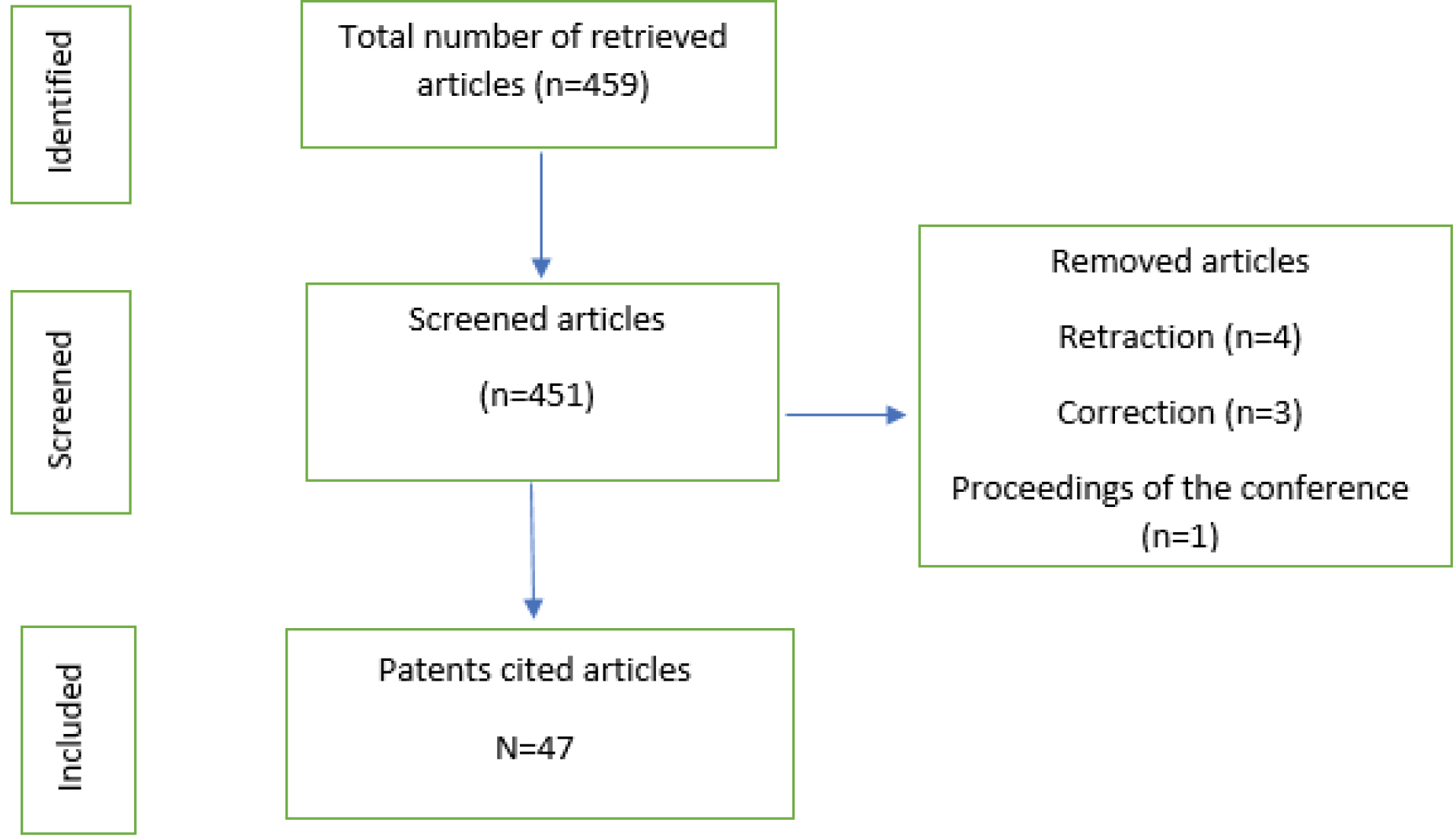
Fig. 1.
A flow diagram of the procedure for selecting the retrieved articles for examination.
.
A flow diagram of the procedure for selecting the retrieved articles for examination.
The articles’ bibliographic data, such as title, name of author(s), publication year, author's affiliation, and number of citations, as well as the bibliographic data of the citing patents like the application number, name of inventor(s), name of applicant(s), publication year and subject area based on the International Patent Classification (IPC)26 scheme were extracted and recorded in the designated checklist[1]. While multiple authors contributed to each article, the contributions of each author and the collaborating authors' organizations and nations were considered the same and equal to 1. Participation in producing at least three articles identified the most prolific authors, organizations, and countries, and the number of similarly productive variables determined the number of top-cited authors, organizations, and countries.
In order to obtain comprehensive bibliographic data, we utilized the Espacenet database to retrieve the complete names of patent applicants because the Lens database occasionally provided only abbreviated information. This database contains information on over 140 million patent documents in more than 100 countries.27
The requested data were retrieved on January 20, 2024, and then analyzed using descriptive statistical analysis and the Excel software.
Results
From the total of 451 articles published in BI, 47 (10.4%) were cited by 168 patents. The total and average citations received by the articles was 169 and 3.6, respectively.
The articles included four types: original research, review, editorial, and hypothesis. The highest number (27) belonged to original research, and review articles received most of the citations[2] (Fig. 2).
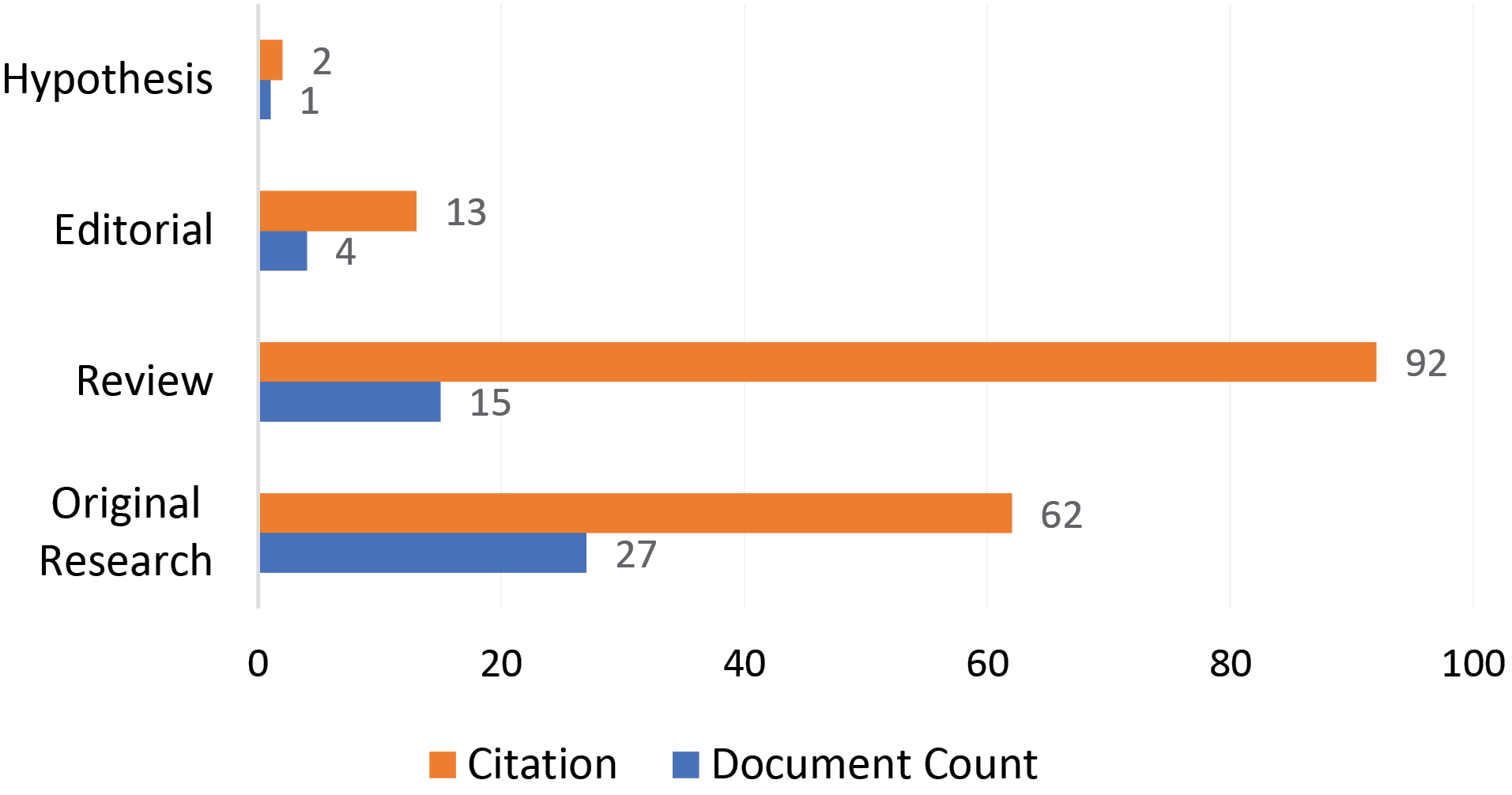
Fig. 2.
Type, count, and citation of cited documents
.
Type, count, and citation of cited documents
Eight articles received more citations than the average. The article by Nokhodchi et al obtained the maximum number of citations (44), followed by Srinivasan Shanmugam’s article with 30 citations as the second most cited (Table 1).
Table 1.
Five highly cited articles by patents in BI
|
Title
|
Author(s)
|
Doc type
|
Citation
|
| N |
% |
| The Role of Oral Controlled Release Matrix Tablets in Drug Delivery Systems28 |
Ali Nokhodchi et al |
Review |
44 |
26 |
| Granulation techniques and technologies: recent progresses29 |
Srinivasan Shanmugam |
Review |
30 |
17.8 |
| Cytotoxic Impacts of Linear and Branched Polyethylenimine Nanostructures in A431 Cells30 |
Vala Kafil, Yadollah Omidi |
Original Research |
13 |
7.7 |
| Heavy Chain Only Antibodies: A New Paradigm in Personalized HER2 + Breast Cancer Therapy31 |
Seyed Moein Moghimi et al. |
Editorial |
7 |
4.14 |
| Role of Lactobacillus plantarum MTCC1325 in membrane-bound transport ATPases system in Alzheimer’s disease-induced rat brain32 |
Nimgampalle Mallikarjuna et al |
Original Research |
6 |
3.6 |
The articles were published with the participation of 159 authors. Seven authors contributed to the publication of at least three articles. Yadollah Omidi and Jaleh Barar were the most active, contributing to the publication of 12 and 11 articles, respectively (Table 2).
Table 2.
Active and influential authors, organizations and countries
|
Variable
|
Document
|
Citation
|
|
N
|
%
|
N
|
%
|
| Author |
Active |
Yadollah Omidi |
12 |
25.3 |
35 |
20.7 |
| Jaleh Barar |
11 |
23.4 |
16 |
9.5 |
| Abolfazl Barzegari |
5 |
10.6 |
5 |
3 |
| Jaber Dehghani |
4 |
8.5 |
6 |
3.6 |
| Marziyeh Fathi |
3 |
6.4 |
6 |
3.6 |
| Mohammad A Rafi |
3 |
6.4 |
4 |
2.4 |
| Mohammad-Reza Rashidi |
3 |
6.4 |
8 |
4.7 |
| Influential |
Ali Nokhodchi |
2 |
4.3 |
48 |
28.4 |
| Kofi Asare-Addo |
1 |
2.1 |
44 |
26 |
| Pryia Patel |
1 |
2.1 |
44 |
26 |
| Shaista Raja |
1 |
2.1 |
44 |
26 |
| Yadollah Omidi |
12 |
25.3 |
35 |
20.7 |
| Srinivasan Shanmugam |
1 |
2.1 |
30 |
17.8 |
| Jaleh Barar |
11 |
23.4 |
16 |
9.5 |
| Organization |
Active |
Tabriz University of Medical Sciences |
24 |
51.1 |
52 |
30.8 |
| Tehran University of Medical Sciences |
4 |
8.5 |
8 |
4.7 |
| University of Tabriz |
3 |
6.4 |
5 |
3 |
| Thomas Jefferson University |
3 |
6.4 |
4 |
2.4 |
| Influential |
Tabriz University of Medical Sciences |
24 |
51.1 |
52 |
30.8 |
| The University of Kent |
2 |
4.3 |
48 |
28.4 |
| University of Huddersfield |
1 |
2.1 |
44 |
26 |
| Hanmi Pharm. Co., Ltd. |
1 |
2.1 |
30 |
17.8 |
| Country |
Active |
Iran |
31 |
66 |
63 |
37.3 |
| United States |
10 |
21.3 |
17 |
10.1 |
| India |
4 |
8.5 |
11 |
6.5 |
| United Kingdom |
3 |
6.4 |
51 |
30.2 |
| Influential |
Iran |
31 |
66 |
63 |
37.3 |
| United Kingdom |
3 |
6.4 |
51 |
30.2 |
| South Korea |
1 |
2.1 |
30 |
17.8 |
| United States |
10 |
21.3 |
17 |
10.1 |
Ali Nokhodchi received 48 citations out of the seven most cited authors, and Kofi Asare-Addo, Pryia Patel, and Shaista Raja received 44 citations (Table 2).
Of the 43 organizations that contributed to producing articles, four organizations produced three or more articles. Contributing to producing 24 papers and having gained 52 citations, TUOMS was determined to be the most productive and the most influential organization (Table 2).
Four countries contributed to producing at least three articles. The most productive country was Iran (31 articles), followed by the United States standing at the second rank (10 articles). Also, Iran and the United Kingdom were the most cited countries, with 63 and 51 citations, respectively (Table 2).
The citing (including granted and application) patents for BI’s articles were released from 2013 to 2023. Most of them (36 patents) belonged to 2020 (Fig. 3).
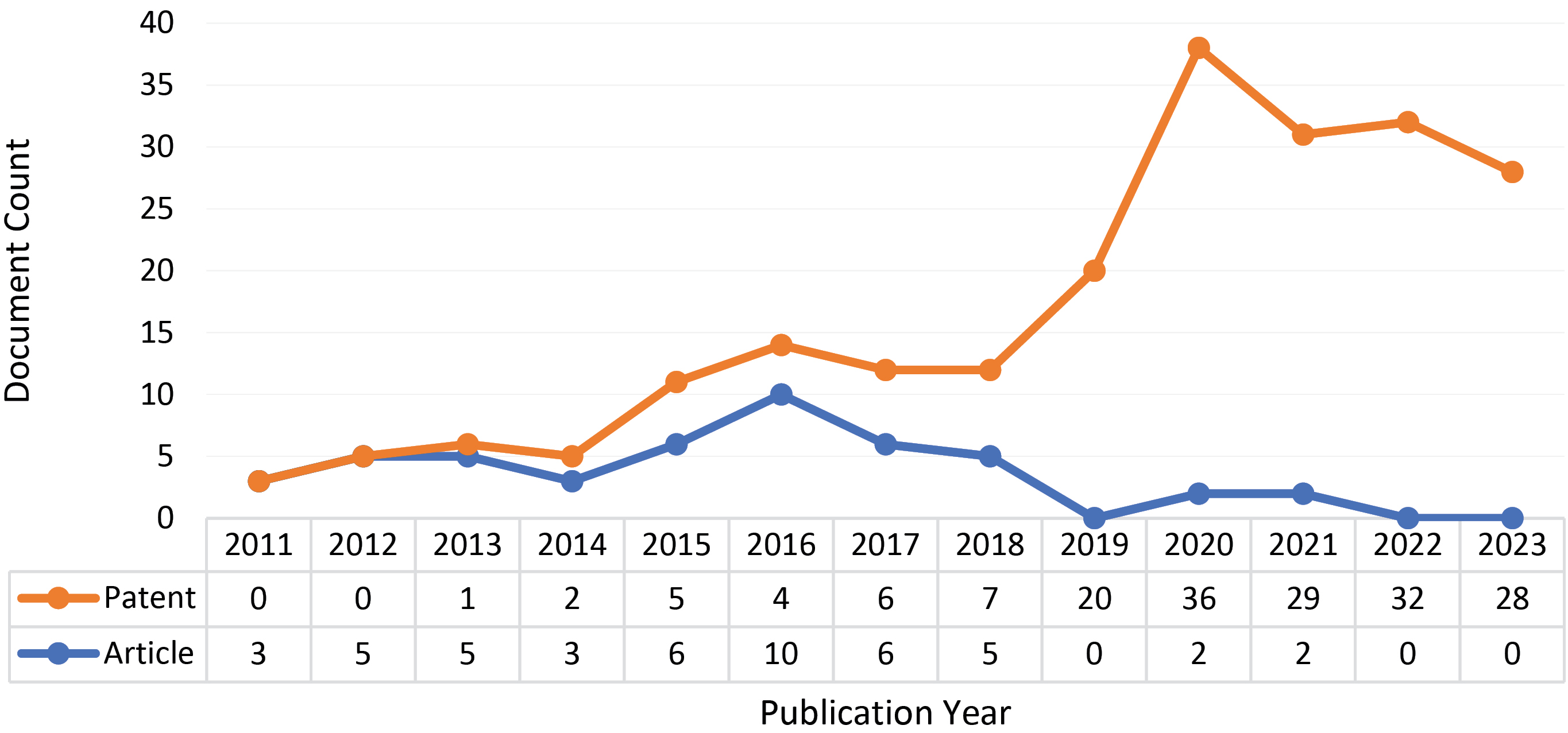
Fig. 3.
Publication year of citing patents and BI’s cited articles.
.
Publication year of citing patents and BI’s cited articles.
Ten patent offices were involved in the registration of the citing patents. The USPTO and the World Intellectual Property Organization (WIPO) were two principal patent offices with 104 and 32 patents registered, respectively (Fig. 4).
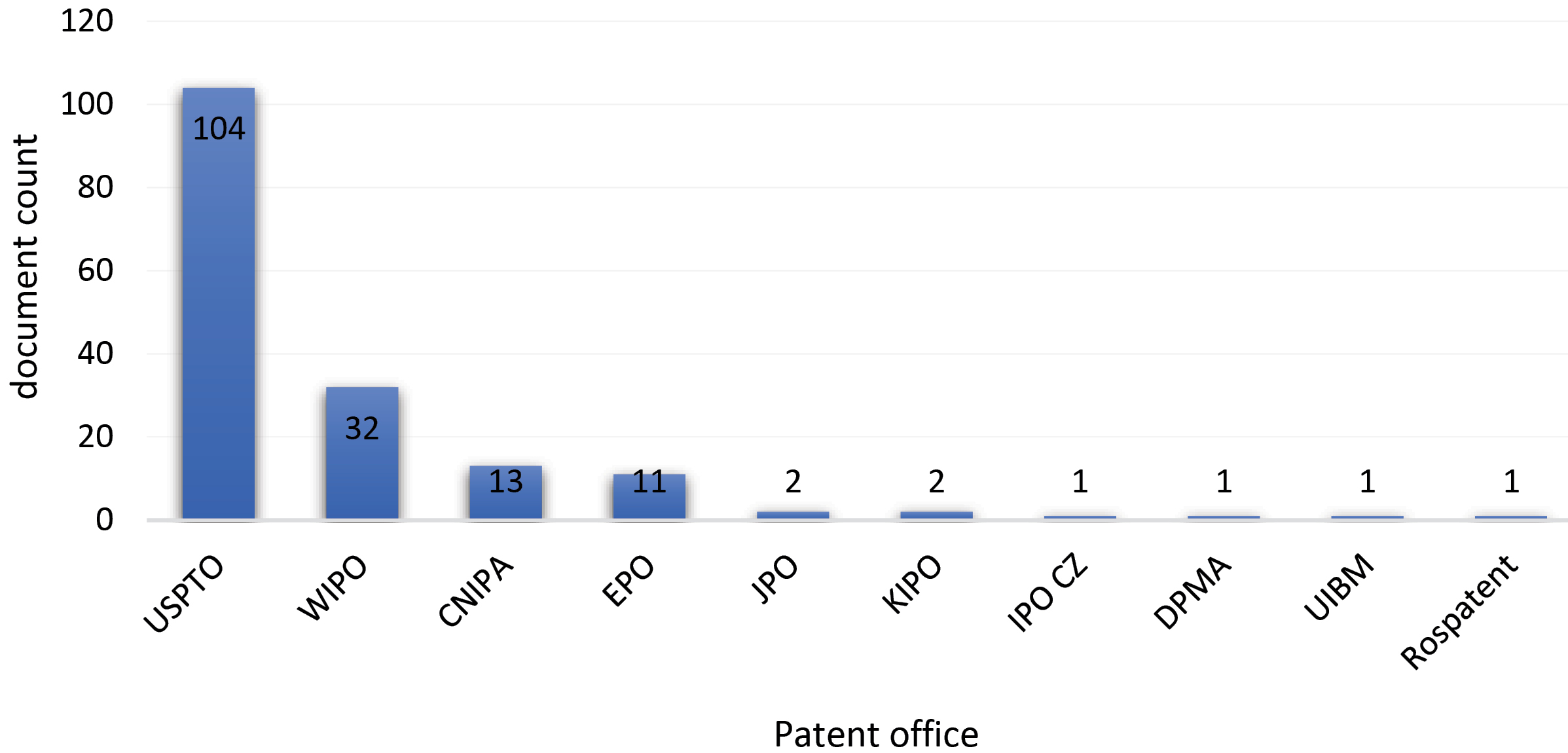
Fig. 4.
Patent offices for citing patents.
.
Patent offices for citing patents.
The citing patents were filed by inventors and applicants from 27 and 26 countries, respectively. The most significant number of patents (76) belonged to the USA, followed by Germany and China being ranked second and third, respectively (Fig. 5).
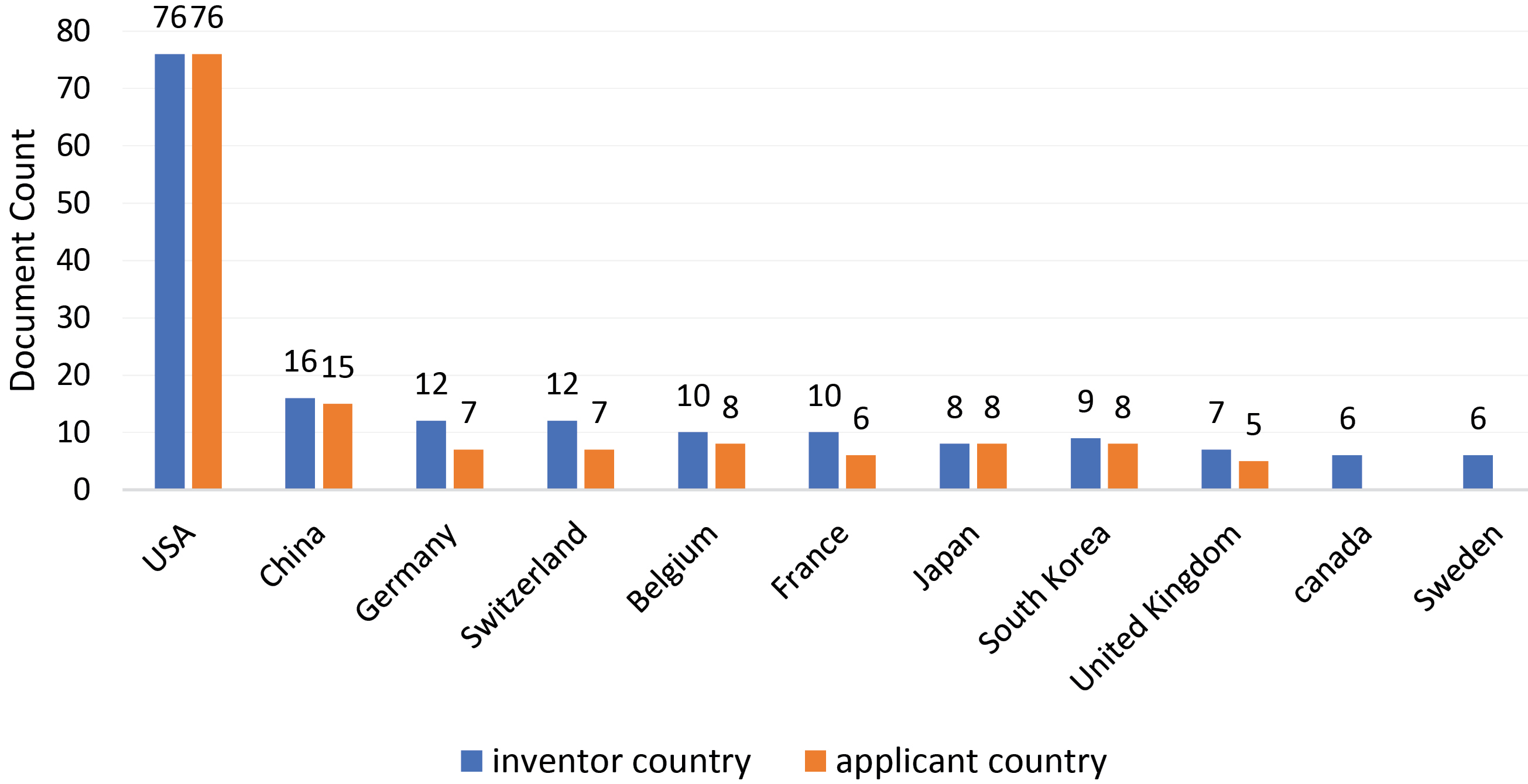
Fig. 5.
Top ten inventor and applicant countries.
.
Top ten inventor and applicant countries.
Articles by Iranian authors were cited by inventors and applicants from 19 and 16 countries, respectively. Of them, American inventors and applicants contributed to producing 12 and 13 of the total number of patents (Fig. 6).
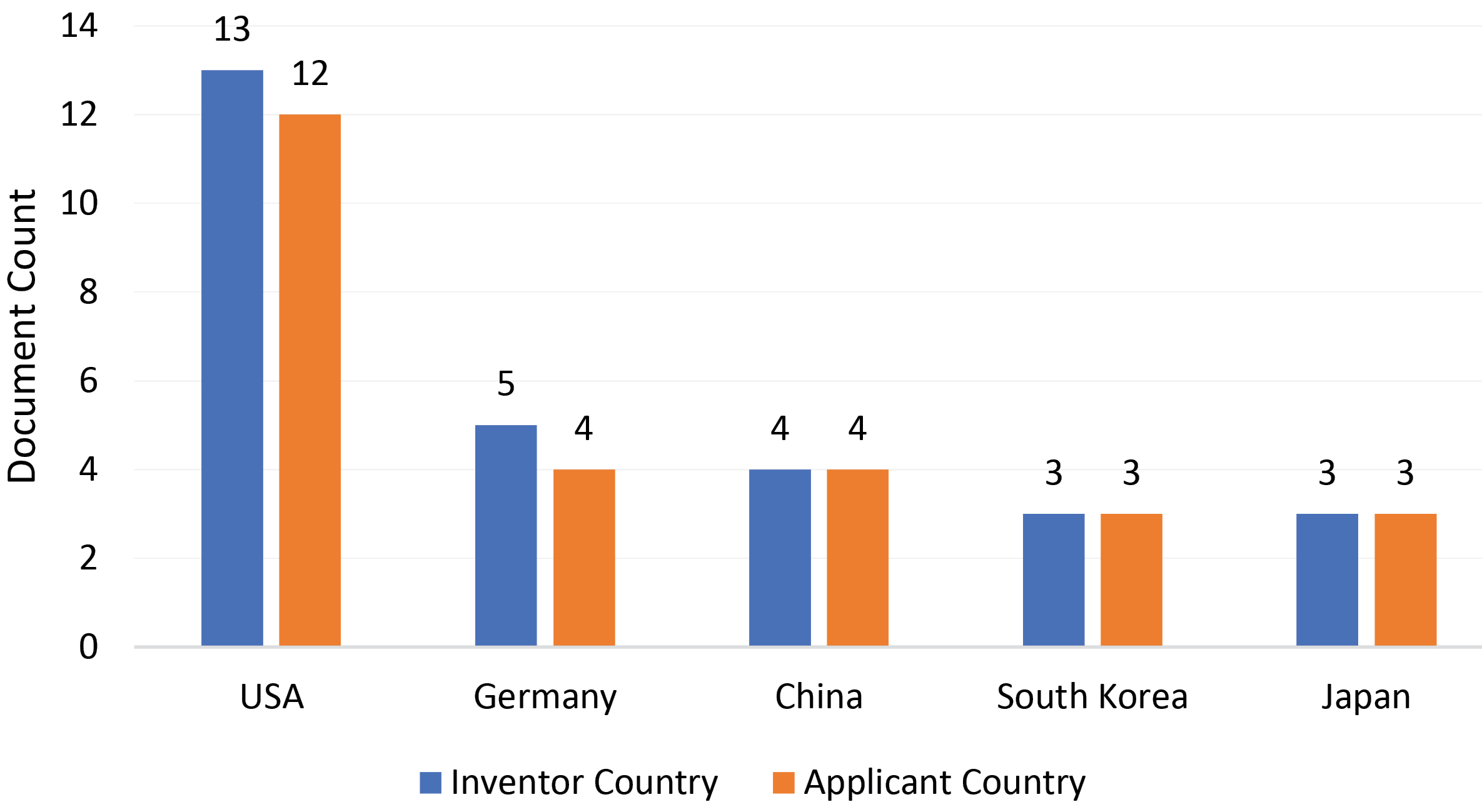
Fig. 6.
Top five countries citing inventors and applicants to Iranian articles.
.
Top five countries citing inventors and applicants to Iranian articles.
The citing patents were categorized into five sections: A, B, C, G, and H, as well as 19 IPC classes. Sections A61 (medical or veterinary science; hygiene), C07 (organic chemistry), and C12 (biochemistry; beer; spirits; wine; vinegar; microbiology; enzymology; mutation or genetic engineering) were the three main categories with the frequency of 497, 94 and 71, respectively (Table 3).
Table 3.
IPC classes of citing patents
|
Section
|
Class
|
N
|
| A:Human Necessities |
A01: Agriculture; Forestry; Animal Husbandry; Hunting; Trapping; Fishing |
6 |
| A23: Foods or Foodstuffs; Treatment Thereof, not Covered by Other Classes |
12 |
| A61: Medical or Veterinary Science; Hygiene |
497 |
| B: Performing Operations; Transporting |
B01: Physical or Chemical Processes or Apparatus in General |
8 |
| B28: Working Cement, Clay, or Stone |
2 |
| B29: Working of Plastics; Working of Substances in a Plastics State in General |
7 |
| C:Chemistry; Metallurgy |
C01: Inorganic Chemistry |
2 |
| C04: Cements; Concrete; Artificial Stone; Ceramics; Refractories |
6 |
| C07: Organic Chemistry |
94 |
| C08: Organic Macromolecular Compounds; Their Preparation or Chemical Working-up; Compositions Based Thereon |
28 |
| C09: Dyes; Paints; Polishes; Natural Resins; Adhesives; Compositions not Otherwise Provided for; Applications of Materials not Otherwise Provided for |
7 |
| C11: Animal or Vegetable Oils, Fats, Fatty Substances or Waxes; Fatty Acids Therefrom; Detergents; Candles |
4 |
| C12: Biochemistry; Beer; Spirits; Wine; Vinegar; Microbiology; Enzymology; Mutation or Genetic Engineering |
71 |
| G: Physics |
G01: Measuring; Testing |
15 |
| G06: Computing; Calculating or Counting |
1 |
| G09: Educating; Cryptography; Display; Advertising; Seals |
1 |
| G10: Musical Instruments; Acoustics |
1 |
| G16: Information and Communication Technology [ICT] Specially Adapted for Specific Application Fields |
1 |
| H:Electricity |
H01: Electric Elements |
8 |
Discussion
This study assessed the technological impact of BI using patent citations. The findings showed that patents cite 10% of the articles. Other studies have shown that patents cite 4-15% of scientific articles.14 For example, according to the Ke survey, approximately 4% of biomedical articles were cited by the US patents.12 A study by Garrido-Cardenas et al. showed that patents cited 15% of the articles published in parasitology journals.14 Hence, BI has an appropriate technological impact.
Reviews had the most citations of any type. Given that 80% of the citations for reviews came from the articles of Nokhodchi et al28 and Shanmugam,29 it can be said that the citations of review articles are influenced mainly by the citations of these two articles, with the remaining 13 review articles receiving a relatively small percentage of the citations. Therefore, it cannot be stated that the type of article affects the quantity of citations received.
Guerrero-Bote et al reported that original papers account for the most significant percentage of articles cited in patents,21 which agrees with our findings.
The number of cited articles and citations obtained differs significantly from the contribution of active and influential authors. The findings indicated the first four influential authors have a few articles overall, and their influence is derived from the impact of a single review article. From a technological viewpoint, it can be stated that the five influential authors have no direct impact because the reviews are the outcome of reviewing other researchers’ publications. It is also necessary to examine the number of citations that active authors receive concerning the type of article to assess their technological effect. Determining the authors' technological H-index might also be helpful in this regard.
TUOMS has been ranked first in terms of activity and impact. Our review revealed that TUOMSauthors produce a significant quantity of BI's articles. A better understanding of its contribution to the technological impact of BI can be obtained by calculating the ratio of its cited articles to its total articles in BI.
After TUOMS, Tehran University of Medical Sciences has been ranked second in technical activity and the average number of citations to its articles is close to TUOMS. In terms of influential organizations, except TUOMS, three other universities with the most significant impact are influenced by a single review article and do not directly affect technology. So, it could be more beneficial to ascertain the universities' technological H-index.
Active and influential countries have the same issues as active and influential organizations. In the present research, the author’s affiliation determines the shares of each organization and country. All organizations and countries where the author has multiple affiliations in an article are assigned one share. A more precise allocation can be found by assigning a relative contribution to each author’s organization and country.
According to the patent publication year, the first citation is two years after the article's publication date, and the last citations are in 2021. This could be due to the 18-month interval between filing an application and publishing it. Finardi notes that the time interval between the publication of an article and the receipt of the first citation from a patent is three to four years,33 which is consistent with our analysis result (about two years).
Most of patents citing BI’s articles are filed in the USPTO. As reported by Zahedi et al, BI received only three citations from the US patents before November 2018.24 Re-examining the patents citing BI’s articles revealed that these articles received 11 US patent citations until 2018, which differed from the findings of Zahedi et al significantly.
The number of patent offices and inventor and applicant countries demonstrates the geographical scope of BI’s articles' technological influence. The USPTO and the USA hold the most significant proportion in this regard. The number of patent citation from various countries and patent offices to non-patent sources is dictated by the patent office's policy and its obligation to refer to prior art. Previous research has demonstrated that US patents are more scientifically founded than those from other countries.10,34,35 Most of patents registered in any country's patent office are owned by its inventors and applicants; hence, BI's articles have the most significant impact on American patents.
Typically, each country's science and technology are in sync and can have the greatest impact on each other within that geographical area. Since prior art is not specified in the patent filed in Iran's Intellectual Property Office, it was impossible to investigate the impact of BI’s articles on relevant technology in Iran.
Zahedi et al reported that up to November 2018, section of chemistry and metallurgy (C) was the only technological area impacted by BI's articles.24 The present study results revealed that five technological sections were impacted, with human necessities (A) and chemistry and metallurgy (C) sections ranked the highest. Re-examination results showed that BI's articles from patents in Section C gained three citations up to the end of 2018, which agrees with the findings of Zahedi et al. Additionally, contrary to the conclusions of Zahedi et al, the citations through the end of 2018 are from sections A, B, and C.
Conclusion
The present research used the index of patents’ citations to scientific articles to examine the technological impact of BI. It was revealed that BI has an appropriate technological impact, and the impact of BI's articles is geographically distributed, indicating its significant visibility and accessibility. Therefore, BI can serve as a valuable information resource for academic and industry researchers working in linked technological domains and as a venue for disseminating their findings. To demonstrate BI's technological prestige and contribution to technological advancement, information about its technological impact must be included on the journal’s website, and suitable policies must be adopted to secure its continued growth. Considering that BI is multidisciplinary, it is suggested to analyze how different types of articles affect the journal's technological impact based on the specific subject area. It is also advisable to undertake a study to evaluate the technological standing of journals in the same subject categories to assess BI's place relative to them. Finally, it is recommended to investigate the technological H-index of the authors.
Research Highlights
What is the current knowledge?
What is new here?
-
The ten patent offices’ patents, mainly the USPTO and the WIPO, are impacted by BI’s articles in five technological sections. Human necessities (A) and chemistry and metallurgy (C) have the highest rank. BI's articles have the most significant impact on American patents.
Competing Interests
The authors declared no conflicts of interest.
Ethical Statement
Not applicable.
Endnotes
[1] IPC has eight sections, including Human Necessities (A); Performing Operations, Transporting (B); Chemistry, Metallurgy (C); Textiles, Paper (D); Fixed constructions (E); Mechanical engineering, Lighting, Heating, Weapon, Blasting (F); Physics (G); Electricity (H).
[2] In this study, four short communications are included in the category of original research and two perspective articles are included in the review category.
References
- Moradzadeh M, Sedghi S, Panahi S. Towards a new paradigm for ‘journal quality’ criteria: a scoping review. Scientometrics 2023; 128:279-321. doi: 10.1007/s11192-022-04520-5 [Crossref] [ Google Scholar]
- Fuyuno I, Cyranoski D. Cash for papers: putting a premium on publication. Nature 2006; 441:792. doi: 10.1038/441792b [Crossref] [ Google Scholar]
- Quan W, Chen B, Shu F. Publish or impoverish: an investigation of the monetary reward system of science in China (1999-2016). Aslib J Inf Manag 2017. 69: 486-502. 10.1108/ajim-01-2017-0014.
- Liaw YC, Chan TY, Fan CY, Chiang CH. Can the technological impact of academic journals be evaluated? The practice of non-patent reference (NPR) analysis. Scientometrics 2014; 101:17-37. doi: 10.1007/s11192-014-1337-0 [Crossref] [ Google Scholar]
- Mousavi Jarahi A, Keihani P, Vaziri E, Feizabadi M. Indicators of evaluating research at article level: recommendation for effective evaluation of APJCP’ scientific performances. Asian Pac J Cancer Prev 2018; 19:1151-4. doi: 10.22034/apjcp.2018.19.5.1151 [Crossref] [ Google Scholar]
- Wang D, Song C, Barabási AL. Quantifying long-term scientific impact. Science 2013; 342:127-32. doi: 10.1126/science.1237825 [Crossref] [ Google Scholar]
- Sinatra R, Wang D, Deville P, Song C, Barabási AL. Quantifying the evolution of individual scientific impact. Science 2016; 354:aaf5239. doi: 10.1126/science.aaf5239 [Crossref] [ Google Scholar]
- Varin C, Cattelan M, Firth D. Statistical modelling of citation exchange between statistics journals. J R Stat Soc Ser A Stat Soc 2016; 179:1-63. doi: 10.1111/rssa.12124 [Crossref] [ Google Scholar]
- Narin F, Noma E. Is technology becoming science?. Scientometrics 1985; 7:369-81. doi: 10.1007/bf02017155 [Crossref] [ Google Scholar]
- Meyer M, Debackere K, Glänzel W. Can applied science be ‘good science’? Exploring the relationship between patent citations and citation impact in nanoscience. Scientometrics 2010; 85:527-39. doi: 10.1007/s11192-009-0154-3 [Crossref] [ Google Scholar]
- Popp D. From science to technology: the value of knowledge from different energy research institutions. Res Policy 2017; 46:1580-94. doi: 10.1016/j.respol.2017.07.011 [Crossref] [ Google Scholar]
- Ke Q. Comparing scientific and technological impact of biomedical research. J Informetr 2018; 12:706-17. doi: 10.1016/j.joi.2018.06.010 [Crossref] [ Google Scholar]
- de Moya-Anegon F, Lopez-Illescas C, Guerrero-Bote V, Moed HF. The citation impact of social sciences and humanities upon patentable technology. Scientometrics 2020; 125:1665-87. doi: 10.1007/s11192-020-03530-5 [Crossref] [ Google Scholar]
- Garrido-Cardenas JA, Alcayde A, Manzano-Agugliaro F, Mesa-Valle CM. Transfer of parasitology research to patents worldwide. Acta Trop 2022; 232:106532. doi: 10.1016/j.actatropica.2022.106532 [Crossref] [ Google Scholar]
- Persoon PG, Bekkers RN, Alkemade F. The science base of renewables. Technol Forecast Soc Change 2020; 158:120121. doi: 10.1016/j.techfore.2020.120121 [Crossref] [ Google Scholar]
- Callaert J, Van Looy B, Verbeek A, Debackere K, Thijs B. Traces of prior art: an analysis of non-patent references found in patent documents. Scientometrics 2006; 69:3-20. doi: 10.1007/s11192-006-0135-8 [Crossref] [ Google Scholar]
- van Vianen BG, Moed HF, van Raan AF. An exploration of the science base of recent technology. Res Policy 1990; 19:61-81. doi: 10.1016/0048-7333(90)90034-4 [Crossref] [ Google Scholar]
- Harhoff D, Scherer FM, Vopel K. Citations, family size, opposition and the value of patent rights. Res Policy 2003; 32:1343-63. doi: 10.1016/s0048-7333(02)00124-5 [Crossref] [ Google Scholar]
- He ZL, Deng M. The evidence of systematic noise in non-patent references: a study of New Zealand companies’ patents. Scientometrics 2007; 72:149-66. doi: 10.1007/s11192-007-1702-3 [Crossref] [ Google Scholar]
- Lo SC. Scientific linkage of science research and technology development: a case of genetic engineering research. Scientometrics 2010; 82:109-20. doi: 10.1007/s11192-009-0036-8 [Crossref] [ Google Scholar]
- Guerrero-Bote VP, Moed HF, Moya-Anegón F. New indicators of the technological impact of scientific production. J Data Inf Sci 2021; 6:36-61. doi: 10.2478/jdis-2021-0028 [Crossref] [ Google Scholar]
- Velayos-Ortega G, López-Carreño R. Indicators for measuring the impact of scientific citations in patents. World Patent Information 2023; 72:102171. doi: 10.1016/j.wpi.2023.102171 [Crossref] [ Google Scholar]
- BioImpacts. About Journal. Available from: https://bi.tbzmed.ac.ir/About. Accessed 2024.
- Zahedi S, Noruzi A, Fahimifar S. Citations to Iranian English-language journals approved by the Iranian Ministry of Health and Medical Education in patents registered in the United States Patent and Trademark Office (USPTO) database. Health Information Management 2019; 16:73-81. doi: 10.22122/him.v16i2.3848 [Crossref] [ Google Scholar]
- Lens. Available from: https://www.lens.org/.
- World Intellectual Property Organization (WIPO). IPC Publication. Available from: https://ipcpub.wipo.int/?notion=scheme&version=20240101&symbol=none&menulang=en&lang=en&viewmode=f&fipcpc=no&showdeleted=yes&indexes=no&headings=yes¬es=yes&direction=o2n&initial=A&cwid=none&tree=no&searchmode=smart. Accessed 2024/02/03.
- Espacenet. Available from: https://worldwide.espacenet.com/.
- Nokhodchi A, Raja S, Patel P, Asare-Addo K. The role of oral controlled release matrix tablets in drug delivery systems. Bioimpacts 2012; 2:175-87. doi: 10.5681/bi.2012.027 [Crossref] [ Google Scholar]
- Shanmugam S. Granulation techniques and technologies: recent progresses. Bioimpacts 2015; 5:55-63. doi: 10.15171/bi.2015.04 [Crossref] [ Google Scholar]
- Kafil V, Omidi Y. Cytotoxic impacts of linear and branched polyethylenimine nanostructures in a431 cells. Bioimpacts 2011; 1:23-30. doi: 10.5681/bi.2011.004 [Crossref] [ Google Scholar]
- Moghimi SM, Rahbarizadeh F, Ahmadvand D, Parhamifar L. Heavy chain only antibodies: a new paradigm in personalized HER2 + breast cancer therapy. Bioimpacts 2013; 3:1-4. doi: 10.5681/bi.2013.009 [Crossref] [ Google Scholar]
- Mallikarjuna N, Praveen K, Yellamma K. Role of Lactobacillus plantarum MTCC1325 in membrane-bound transport ATPases system in Alzheimer's disease-induced rat brain. Bioimpacts 2016; 6:203-9. doi: 10.15171/bi.2016.27 [Crossref] [ Google Scholar]
- Finardi U. Time relations between scientific production and patenting of knowledge: the case of nanotechnologies. Scientometrics 2011; 89:37-50. doi: 10.1007/s11192-011-0443-5 [Crossref] [ Google Scholar]
- Gazni A. The growing number of patent citations to scientific papers: changes in the world, nations, and fields. Technol Soc 2020; 62:101276. doi: 10.1016/j.techsoc.2020.101276 [Crossref] [ Google Scholar]
- Glänzel W, Zhou P. Publication activity, citation impact and bi-directional links between publications and patents in biotechnology. Scientometrics 2011; 86:505-25. doi: 10.1007/s11192-010-0269-6 [Crossref] [ Google Scholar]